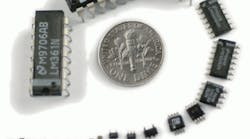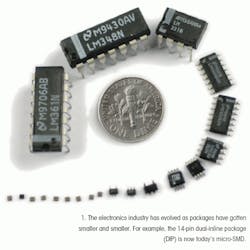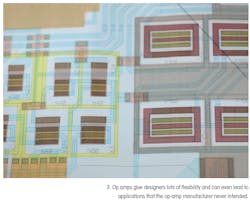This article is in Bob Pease on Analog Vol. 1 in the Analog section of the Electronic Design Library.
Members can download the PDF ebook.
For many years, aficionados of digital circuits and computers have bragged that their rapid advances will leave all analog circuits lying in the dust. The analog business is shrinking, at least compared to the success of digital computers. Moore’s law has made sure of that for many years. The tiny transistors are smaller and faster than ever, even if they can’t stand off 5 V (Fig. 1).
The efforts of a team of digital men who engineered and fit together a few hundred transistors has given way to automated schemes to assemble many thousands, many millions, and now billions of transistors. Boy, every circuit must cost millions of bucks! That means every microprocessor or systemon- a-chip (SoC) must be very profitable! Right?
Wrong. It ignores the fact that several thousand digital transistors may now sell for less than a penny. Digital IC makers must give away a million transistors to make a few bucks. This isn’t necessarily true for analog circuits. A couple dozen years ago, we handed out some license plate frames in Silicon Valley that said “One good op amp is worth 1000 microprocessors.” We still believe that!
A digital computer can do some things by computing the facts it is told. But to perform a useful function, it often needs a good bit of analog information. It needs to get information from the world or from its user. It also needs to get this data from sensors, where the information is channeled through analog preamps and/or filters. Usually, analog engineers have to engineer these channels. A brute-force approach generally doesn’t work.
Some sensors put out a signal that can be acquired directly by a fairly simple analog-to-digital converter (ADC) that interfaces to the sensor. But, typically, a high-performance ADC needs an anti-aliasing filter to prevent the sampling from turning high-frequency noises and spikes into low-frequency “artifacts.”
What kind of filter is needed, and how many dB of attenuation are needed at the sampling frequency? The person who designs that filter has to complete the filter engineering in the analog domain. You can’t do it with digital signal processing (DSP). You must have a good analog filter before you get the information converted into signals that can be processed by DSP.
Now, in theory, it sounds like an ADC or digitalto- analog converter (DAC) will be designed by one analog group and one digital group that sit down, shake hands across a table, and figure out how to get their circuits to do a handshake, too (Fig. 2). But in practice, most high-performance ADCs are designed by analog engineers. They have to figure out how all of the signals and waveforms will get along without causing trouble.
Yes, they do have to handle some digital signals, but that’s not too hard. We analog engineers know how to handle “digital” signals without excessive bounce or overshoot! We know how to design and lay out transmission lines, terminated as needed.
Sure, some ADCs are integrated onto the main SoC, but these are mostly the low-performance (slow or low-resolution) ones. High-performance ones are usually done off-chip. They are often more costeffective or time-effective.
Thus, analog circuits are also needed alongside modern microprocessors. Engineers used to try to add a lot of analog functions into the processor. But smaller feature sizes, faster logic, and low operating voltages have forced DIS-integration because a decent audio amplifier, low-noise preamp, bandgap reference, high-resolution ADC, or anti-aliassing filter can’t be made (profitably or at all) on such a low-voltage chip.
So, these functions are often being added as external chips. They don’t hurt the yield, as they might if they’re integrated on the main chip. They don’t delay release of a system that is nearly finished. Mindless attempts at further integration have, in many cases, been replaced with disintegration.
There are still applications for digital computers, where most of the work is just computation. When the computing is all done, after a few hours, the computer spits out the answer: “42.” But these days, there’s often a lot of interaction between the user and the computer.
Sensors are needed. And, the sensor needs an ADC to convert the variable (force, position, pressure, temperature) into a digital format so the processor can figure out what to do with that information.
Temperature is one of the parameters that SoCs often try to sense. Sometimes the system wants to know the ambient temperature. Sometimes it also wants to know about the processor’s temperature to help prevent overheating. It isn’t impossible to do this with the temperature computation done on the main chip. However, it’s usually better, cheaper, and easier to do it accurately with an external (disintegrated) temperature-measuring circuit off the main SoC.
This is often done with a remote diode temperature sensor (RDTS), which can sense temperature using almost any kind of stable diode or transistor. It can even sense the temperature of one transistor built into the middle of the main processor and, thus, protect it. Of course, detecting the ambient temp requires an off-chip sensor. Why not put the temp measuring function off-chip?
Voltage Regulator Stuff
It’s quite true that many CMOS ICs can run on a wide range of power-supply voltages. So, you can get some things done by running them on a small battery. But modern high-performance CMOS circuits run fast on a low-voltage supply. If the battery voltage runs low, the CMOS runs slow, and the timing may suffer. If the battery gets too high, the CMOS starts to break down and overheat. So, modern CMOS circuits need to run with a regulated supply.Many low-dropout (LDO) regulators can run accurately on low voltages and regulate a battery source down to a lower voltage, but they generally aren’t very efficient. LDOs often waste as much power as they put out. So while they are quite useful in some cases, they won’t let you run your cellular phone for a long time. I mean, which would you buy—a cell phone or computer that runs for three hours or six hours?
That’s why we need switch-mode regulators to get good efficiency. Aha! A switcher has drivers and power MOSFETs that turn on and off—a bang-bang controller. That must be a good digital application!
But not at all. While the nominal voltage levels seem to be ones and zeros, the actual output voltage depends precisely on the time ratio or duty cycle of those apparently “bang-bang” signals. The duty cycle of these signals is an analog function and is controlled by an analog controller. So all computers these days run on regulated power, regulated by analog switch-mode controllers—controllers designed by analog designers.
The only digital things in those controllers are the techniques by which the fast duty-cycle signals are driven. And even these need analog techniques to help them behave and save power. On a good day, analog engineers are wild men about saving power. Sometimes we are very good at it.
Even a digital computer may need analog circuits, such as low-voltage differential signaling (LVDS), to transfer a lot of data from place to place. All you digital engineers now know that you can’t just feed some full-size digital signals at high speed to a different location, like on a backplane, or on flex cabling, at flat-out speed.
You have to engineer (using refined techniques) the signals into small, balanced (push-pull) differential signals. Then, you have to put the signals on carefully laid-out transmission lines. And, you have to use nice little preamps to recover the signals at the required place. Note that these are analog techniques.
I used to think that LVDS was the dumbest idea in the world. Why would anybody buy that? Then, after a long time, I began to realize that if LVDS were so stupid, nobody would buy it. Yet these LVDS drivers, multiplexers, and receivers were selling well, and the business was even expanding. It was I who was kind of dumb.
People wouldn’t buy them if they weren’t useful, cost-effective, and valuable, even if I was too stupid and slow to see the value. After all, it was my old colleague Jay Last, one of the original Fairchild Eight, who observed, “The only valid market survey is a signed purchase order.” A lot of analog circuits are sold that way. The customer knows what the ICs are useful for, even if the maker does not.
An operational amplifier is called that because it can perform just about any operation according to what feedback components you put around it. The beauty of the op amp is exactly what things the customer can (and does) think to do with an amplifier, or a regulator, that we never thought of or told him how to do (Fig. 3).
New applications are invented every day! Often, the customer does that inventing. Sometimes he tells us what he’s doing or asks if it’s okay. But usually he is too busy to tell us, and sometimes he really doesn’t want to tell anybody.
Analog drivers are also needed for backplane drivers and display drivers in computer displays. Getting a lot of info up there needs careful analog planning, not just a lot of wires. There are still a lot of applications that depend on layout to get a circuit to work well. And, many parts of a good layout depend on analog engineering.
Some wireless techniques rely on a lot of digital codes. That’s very true. But to pick these codes out of the air, the preamps need analog techniques, with good RF preamps. They need mixers and AVC circuits to avoid overloading. I’m not a very good RF engineer, but I know that the art of RF engineering isn’t simple. If a digital engineer can do it, that is all very good, but then we should properly call him an RF engineer.
What's Next?
Are we analog engineers worried about the analog business dying out? I don’t think so. Every year, we are confronted with more work and problems than we can do in a year and a half or two years. Most of it is profitable. A lot of it is fun! If I weren’t having fun, I would go away and do something else.
I’ve never been tempted to do that. The analog business is almost always challenging. Our work often involves challenges where computers or simulation cannot help us. But experimenting often can. And thinking often can.
In the last year, some of my buddies showed me some excellent audio amplifiers with nonlinearity down near or below 1 ppm. I studied around and measured, and I found these amplifiers were actually 10 times better than the engineers thought they were, using advanced analog measurement and analysis techniques.. I also cheated by bringing in various resistor and series R-C networks. There are still things you can do with Rs and Cs that are fun ways to solve problems, and they are not obvious!
If you’re an analog engineer, don’t jump off any bridges because somebody tells you that Moore’s law will put you out of business. (In actuality, I have indications and proofs showing that Moore’s law is the one in trouble.) Stick together with your analog buddies and keep solving tough problems. I think you will be rewarded. We’re going to keep on having a lot of fun— analog circuit fun.
Comments invited!
Read more article from Bob Pease on Analog Vol. 1.




